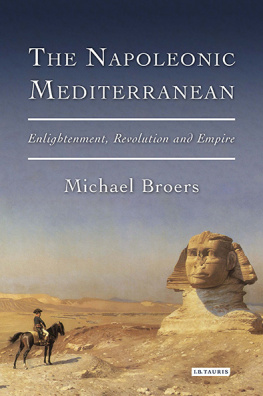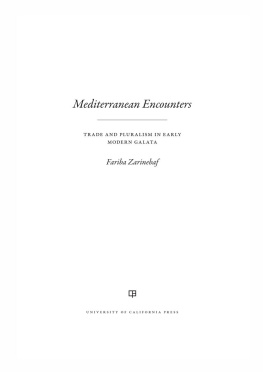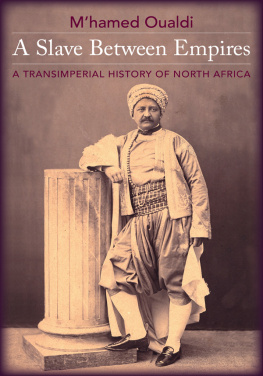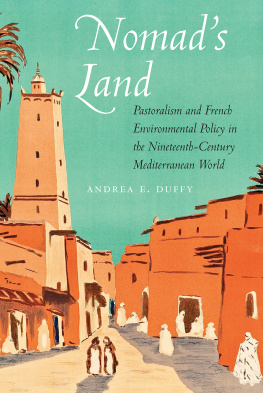MEDITERRANEANS
FRENCH
FRANCE OVERSEAS:
STUDIES IN EMPIRE AND DECOLONIZATION
Series editors: A. J. B. Johnston, James D. Le Sueur, and Tyler Stovall
French Mediterraneans
Transnational and Imperial Histories
Edited and with an introduction by Patricia M. E. Lorcin and Todd Shepard
UNIVERSITY OF NEBRASKA PRESS
Lincoln and London
2016 by the Board of Regents of the University of Nebraska All rights reserved Manufactured in the United States of America
Library of Congress Cataloging
in-Publication Data
Names: Lorcin, Patricia M. E. |
Shepard, Todd, 1969
Title: French Mediterraneans: transnational and imperial histories / Edited and with an introduction by Patricia M. E. Lorcin and Todd Shepard.
Description: Lincoln:
University of Nebraska Press, 2016.
Series: France overseas: studies in empire and decolonization | Includes bibliographical references and index. Identifiers: LCCN 2015023758 ISBN 9780803249936 (cloth: alkaline paper) ISBN 9780803288751 (epub)
ISBN 9780803288768 (mobi)
ISBN 9780803288775 (pdf)
Subjects: LCSH: Mediterranean RegionRelationsFrance. | France RelationsMediterranean Region. | Transnationalism History. | Imperialism History. | FrenchMediterranean RegionHistory. | Mediterranean RegionEthnic relationsHistory. Classification: LCC DE85.5.F8 F74 2016 | DDC 303.48/224401822dc23 LC record available at http://lccn.loc.gov/2015023758
Set in Charis by L. Auten.
Designed by N. Putens.
CONTENTS
List of Illustrations vii List of Tables ix
Introduction 1
PATRICIA M. E. LORCIN AND TODD SHEPARD
PART I. RETHINKING MEDITERRANEAN MAPS (MAPS TO RETHINK THE mediterranean)
Rvolutions de Constantinople:
France and the Ottoman World in the Age of Revolutions 21 ALI YAYCIOGLU
2. Barbary and Revolution: France and North Africa, 1789-1798 52 IAN COLLER
3. There Is, in the Heart of Asia,... an Entirely French Population: France, Mount Lebanon, and the Workings of Affective
Empire in the Mediterranean, 1830-1920 76 ANDREW ARSAN
4. Natural Disaster, Globalization, and Decolonization:
The Case of the 1960 Agadir Earthquake 101 SPENCER SEGALLA
PART II. SHIFTING FRAMEWORKS OF MIGRATION (MIGRATIONS ACROSS THE mediterranean)
5. The French Nation of Constantinople in the Eighteenth Century as Reflected in the Saints Peter and Paul Parish Records, 1740-1800 131 EDHEM ELDEM
6. An Ottoman in Paris: A Tale of Mediterranean Coinage 168 MARC AYMES
7. From Household to Schoolroom: Women, Transnational Networks, and Education in North Africa and Beyond 200 JULIA CLANCY-SMITH
8. Europeans before Europe? The Mediterranean Prehistory of European Integration and Exclusion 232 MARY DEWHURST LEWIS
PART III. MARGINS REMADE (BY THE MEDITERRANEAN)
9. Dreyfus in the Sahara: Jews, Trans-Saharan Commerce, and Southern Algeria under French Colonial Rule 265 SARAH ABREVAYA STEIN
10. Moise Nahon and the Invention of the Modern Maghrebi Jew 293 SUSAN GILSON MILLER
11. The Syphilitic Arab? A Search for Civilization in Disease Etiology, Native Prostitution, and French Colonial Medicine 320 ELLEN AMSTER
12. From Auschwitz to Algeria: The Mediterranean Limits of the French Anti-Concentration Camp Movement, 1952-1959 347 EMMA KUBY
Bibliography 373 List of Contributors 409 Index 413
ILLUSTRATIONS
5.1. Staying French: Patterns of endogamy among the Rambaud and Allon families 160
5.2. Mixing blood I: French families grafting upon a local dynasty 162
5.3. Mixing blood II: The Chnier and Amic families Levantine heritage 164
5.4. Mixing blood III: The Dellarocca familys multiple French alliances 166
6.1. Three drafts of stamps to be used for authenticated documents 176
6.2. Detailed view of stamp used for authenticated documents 176
6.3. Letter from J. Anastassiades to the consul general of Russia, 1884 177
6.4. Detailed view of letter from J. Anastassiades to the consul general of Russia, 1884 177
6.5. Mold for an Ottoman debenture bond 185
6.6. Ottoman debenture bond, 1865 186
8.1. The Ceuta-Morocco border, February 2006 233
8.2. Tattered passport showing origin in department of Algiers 243
11.1. Lacapres schematic of the evolution of Arab syphilis 329
11.2. Children with dental abnormalities from hereditary Arab syphilis 330
11.3. Infant born with birth defect from hereditary Arab syphilis 330
11.4. Large X-ray machine used for radiothrapie in the Lemtiyyine clinic 332
11.5. The malnourished, inadequately clothed Bousbir prostitute 336
TABLES
5.1. Origin and gender of individuals in all parish records 135
5.2. Occupations in death, marriage, and baptism records 138
5.3. Occupations in death and baptism records among major groups 139
5.4. Origin and gender in death records with and without itinerant individuals 141
5.5. Endogamy and exogamy among the main communities according to marriage and baptism records 142
5.6. Origin of the spouses of French individuals according to baptism and marriage records 143
5.7. Occupation of French subjects residing in Constantinople in 1723 144
5.8. Occupation of French subjects residing in Constantinople in 1769 145
FRENCH
MEDITERRANEANS
Introduction
PATRICIA M. E. LORCIN AND TODD SHEPARD
The Mediterranean is associated with many images: the seat of Western civilization, the domain of the crusaders, a site of Islamic learning and culture, the playground of corsairs and slavers, a locus of exoticism and sexual fantasy, a space of exchanges, migrations, and invented or reinvented identities, andof relevance to this volumean imperial sea. Recent scholarship on the early modern history of the Mediterranean proposes that the concept of this sea as a unified space is essentially a Western one, devised by the imperial powers that patrolled its seas and controlled its ports.1 The peoples of its southern shores (in particular in the Islamic states), such work suggests, did not share this conception of the sea: rather, for them the Mediterranean was polymorphous, shifting with the economic and seafaring exigencies of the moment. By the nineteenth century, however, the idea that the Mediterranean was a unified space had either been absorbed by, or imposed on, the populations living along its southern shores. This volume reveals the significant French element in the nineteenth- and twentieth-century making of this singular Mediterranean. Mediterranean perspectives, in turn, reposition current arguments that modern French history must be understood as transnational and imperial. To these ends, French
Mediterraneans offers a critical study of space and movement anchored in distinct methodological lenses and interdisciplinary approaches.
Since the early 1990s, efforts to treat metropole and colony in a single analytic field have been crucial to the most important works in Anglophone scholarship on modern France.2 More recently, transnational scholarship has turned to other frames besides empire as well as non-colonial networks to explore French histories. We have learned much about how French people and French states were shaped in other contexts, and by non-French people. This volume aims to open perspectives that shed light on what has been obscured by blind spots apparent in such work. We seek to do so while maintaining the crucial insights they offer into the circulation and play of power (notably, its racialized and imperial forms). We also remain committed to the need that such approaches highlight to think beyond the limits of national histories and across or outside national boundaries, compartmentalized cultures, and the presumed preeminence of state actors. Scholars trained in French history, including the editors, have benefited enormously from the colonial and transnational turns.
Next page







